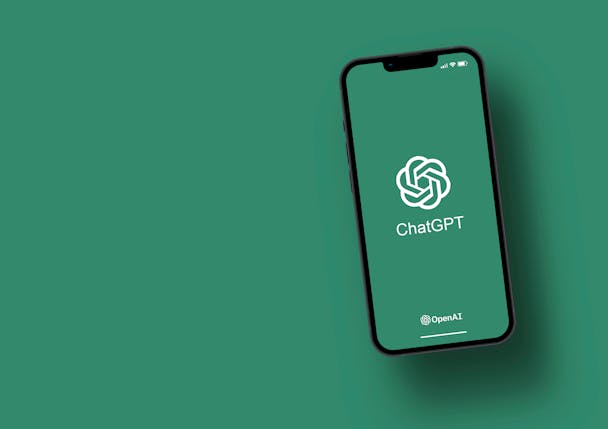Here’s how 7 major ad agencies are currently using AI
Ad agencies can’t stop talking about AI. But how much of that rampant enthusiasm has translated into tangible results? And how are they actually applying the tech? We decided to find out in an effort to separate the reality from the hype.

The launch of ChatGPT in late 2022 helped to spark a wave of interest in generative AI throughout the ad industry. / Adobe Stock
For many of us, the subject of AI has been inescapable over the past several months. It’s everywhere – whether you’re making casual conversation at a party or doom-scrolling Twitter. At Cannes Lions, temporary seat of the advertising universe, AI was utterly ubiquitous.
But as the hype cycle churns on, many marketing teams seem to be unsure about how to use AI – and especially generative AI – in a manner which is simultaneously productive, safe and likely to stand out from the crowd of many other agencies doing the exact same thing.
As New York Times correspondent Kevin Roose reported in a recent episode of the podcast Hard Fork following his experience at Cannes, “everyone’s talking about AI, but nobody here seems to know exactly what to do with AI. Like, all these companies [are] talking up their AI strategies, and their products, and how they’re using generative AI in experiments for maybe their creative team, but if you really start drilling down into what they’re actually doing, it’s not cutting-edge generative AI stuff… most of it is stuff that frankly existed a few years ago.”
Advertisement
In order to get a clearer sense of the current state of AI within the marketing industry, we reached out to some leading agencies that have been touting their AI credentials with a simple question: how are you currently leveraging AI in order to serve your employees and your clients?
Here’s what we've heard:
VMLY&R
"Until recently, AI required engineers and data scientists. But since ChatGPT, Midjourney and other models exploded onto the scene, the barriers to entry dropped dramatically. So we (and our clients) have shifted from occasionally using AI to determining where to integrate AI into all aspects of our work.
"As an agency, we're embracing the potential of AI while building and deploying as responsibly and safely as possible. That includes:
Responsible AI methodologies: Processes to build humans-in-the-loop; frameworks to mitigate risk; making sure any that we use AI is explainable.
Education and training: Helping our teams and clients understand what’s possible and how to use AI tools and platforms.
AI-Powered campaigns and experiences for clients: Most recently, we launched a generative AI experience with a brand spokesperson.
"It’s an especially crazy time, and as the landscape rapidly changes, we’ll continue to evaluate our strategies, priorities and partners."
- Brian Yamada, chief innovation officer
Code and Theory
"Through a partnership with Oracle, Code and Theory is working to deliver AI-powered solutions to clients in the financial, automotive, retail and hospitality industries.
"Some of the use cases we are pursuing with our clients include:
- Implementing a genAI illustration engine for an e-commerce client to consistently refresh their website with new assets, creating a dynamic and engaging user experience.
- Building a proprietary research large language model (LLM) for a finance company, leveraging years of proprietary research data to uncover previously unseen trends.
- Collaborating with a publisher to envision an AI-equipped newsroom. By utilizing genAI, they can accelerate news cycles, explore new content formats and generate custom content seamlessly, introducing new monetization opportunities and allowing users to personalize their news experiences.
"Internally, we employ AI models such as ChatGPT and Bard for multiple use cases. Apart from copywriting, research sourcing and SEO tagging, our strategy and research teams train these models to mimic client brand personas.
"Our agency has adopted various AI tools and frameworks, supporting our strategy, design, and engineering functions. For image generation, we focus on Midjourney and Stable Diffusion (usually a combination of the two), utilizing a custom private cloud instance through our partnership with Oracle to enhance rendering speed.
"We actively explore new AI tools and encourage sandboxing among our employees through our #AI-Garden Slack channel. Once small teams gravitate towards a specific AI model, generating innovative ideas and concepts, we consider it a viable option and proceed with proof of concept and implementation. Our goal is to continuously improve our workflows by discovering and experimenting with new tools."
- David DiCamillo, chief technology officer
Advertisement
Havas New York
"At Havas New York, we’ve noticed how platforms like ChatGPT and Midjourney have increased our ability to quickly create comps and find supporting research, which leaves our teams with more time to think of big ideas.
"To stay compliant, we've adopted a 'play, don’t publish' approach, which encourages our people to freely explore the strengths and weaknesses of AI with strong guidelines around compliance, confidentiality, attribution and usage.
"Since AI is such a new technology, we encourage experimentation. And our creatives have been sharing tips and tricks with the rest of the agency to help everyone get the most out of each platform. At the network level, we have also established an AI task force dedicated to learning and development.
"AI – while massively impressive – comes with certain limitations, such as the tendency to occasionally produce factually inaccurate texts and to propagate certain biases. So we’re careful not to believe everything ChatGPT tells us. We also believe that AI will never be able to replace individual human experiences and idiosyncrasies, and the influence that these have upon our work."
- Dan Lucey, chief creative officer
WPP
"AI is already a fundamental part of WPP’s business, from automating workflows to accelerating ideation and delivering work for clients like Nike, Nestlé, HSBC and Mondelēz’s Cadbury’s.
"Collaborations with industry-leading tech companies like Adobe, IBM, Microsoft, Google, OpenAI and Nvidia are at the core of our approach to AI. Our exclusive partnership with Nvidia, for example, resulted in the world's first generative AI content engine at scale, as unveiled by Jensen Huang in May. This solution merges clients’ manufacturing data with Nvidia Omniverse to generate photorealistic digital twins of branded products.
"WPP’s data company Choreograph has a central role in our AI strategy, delivering work for clients such as Ford, Unilever, Bayer, The Coca-Cola Company and Verizon. WPP acquired AI company Satalia in 2021, and we also hired our first head of creative AI in 2019.
"Conscious of the potential risks associated with AI, we have introduced measures to ensure responsible and ethical use. The company has established network-wide principles, guidance and legal advice to help our people and clients navigate the potential risks posed by AI, which include biases and misinformation.
"We see AI as an enhancer of human creativity rather than a replacement. The company is focused on learning and development for our people, ensuring that they’re equipped with essential skills for modern marketing – including AI competency."
- Stephan Pretorius, chief technology officer
Suggested newsletters for you
TBWA
"We've deeply integrated AI into our business operations and into our creative process. When it comes to generative AI, however, we’re excited but also taking a measured approach given the speed at which the tech is evolving.
"Our top priority has been to ensure that we have the right safety measures in place to allow for responsible innovation across our TBWA Collective. This extends to the types of tools and partnerships that we integrate into our business – which Omnicom has been leading with Google, Microsoft and Adobe – to ensure our people have the best (and safest) tools available to them.
"With those measures in place, we are now deep in research, development and experimentation to explore the strategic and creative applications of genAI. We've created educational resources, practical toolkits and new ways of working through Next, our global innovation practice. Our focus now is on how we can use these tools to create more value and impact for our clients. Looking two to three years out, we're envisioning the impact that genAI will have upon brand experiences and how the technology will revolutionize the ways in which people interact with brands."
- Luke Eid, chief innovation officer
McCann Worldgroup
"We see AI as a copilot to human creativity, enhancing and complementing our capabilities rather than replacing them. The technology serves as a catalyst, unlocking productivity, fueling creative efficiency and enabling us to reimagine new products and services in this era of technological revolution.
"We're committed to the ethical use of AI, striving to make a positive difference in the industry and society at large. Comprehensive training is also of utmost importance to us; we equip our employees with a deep understanding of AI technologies in order to promote ethical, responsible and inclusive use, and we also extend our expertise to clients through tailored training and educational programs.
"AI is a powerful tool that empowers us to enhance efficiency and create personalized experiences. For instance, we have collaborated with Bimbo in Mexico, leveraging generative AI to develop captivating personalized branding for more than 8400 local food vendors. We’ve also utilized AI-assisted techniques to bring the imaginations of players to life through jackpot fantasies for New York Lottery."
- Elav Horwitz, global director of applied innovation
Huge
"Our agency has been developing [an AI] strategy for the past two years. Over that time, we've found that much of the popular discussion around the technology tends to focus on doing the same things our industry has always done, just faster or cheaper. We view AI as a tool that can help us to open entirely new creative growth opportunities for ourselves and the companies we partner with.
"With that in mind, we launched our proprietary, AI-powered Huge Living Intelligence Value Engine (LIVE), which analyzes billions of diverse data points from numerous sources to unearth hidden trends and insights in real time. LIVE is also being used to design an evolving suite of proprietary SaaS products. The Creative Capital Index (CCI), a tool to help businesses measure and increase their organizational creativity, was the first to be introduced.
"For now, Huge is primarily (although not exclusively) using AI as input to bolster our creative thinking rather than generating creative outputs.
"The rapidly evolving nature of AI, coupled with its potential societal impacts and the still-developing legal landscape in which it's embedded make it imperative for anyone using AI to do so responsibly. That's why we're setting clear parameters on when and how we use generative AI and educating our clients every step of the way."
- Lisa De Bonis, global chief product officer
For more on the latest happenings in AI, web3 and other cutting-edge technologies, sign up for The Emerging Tech Briefing newsletter here.

